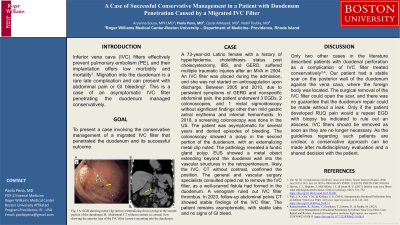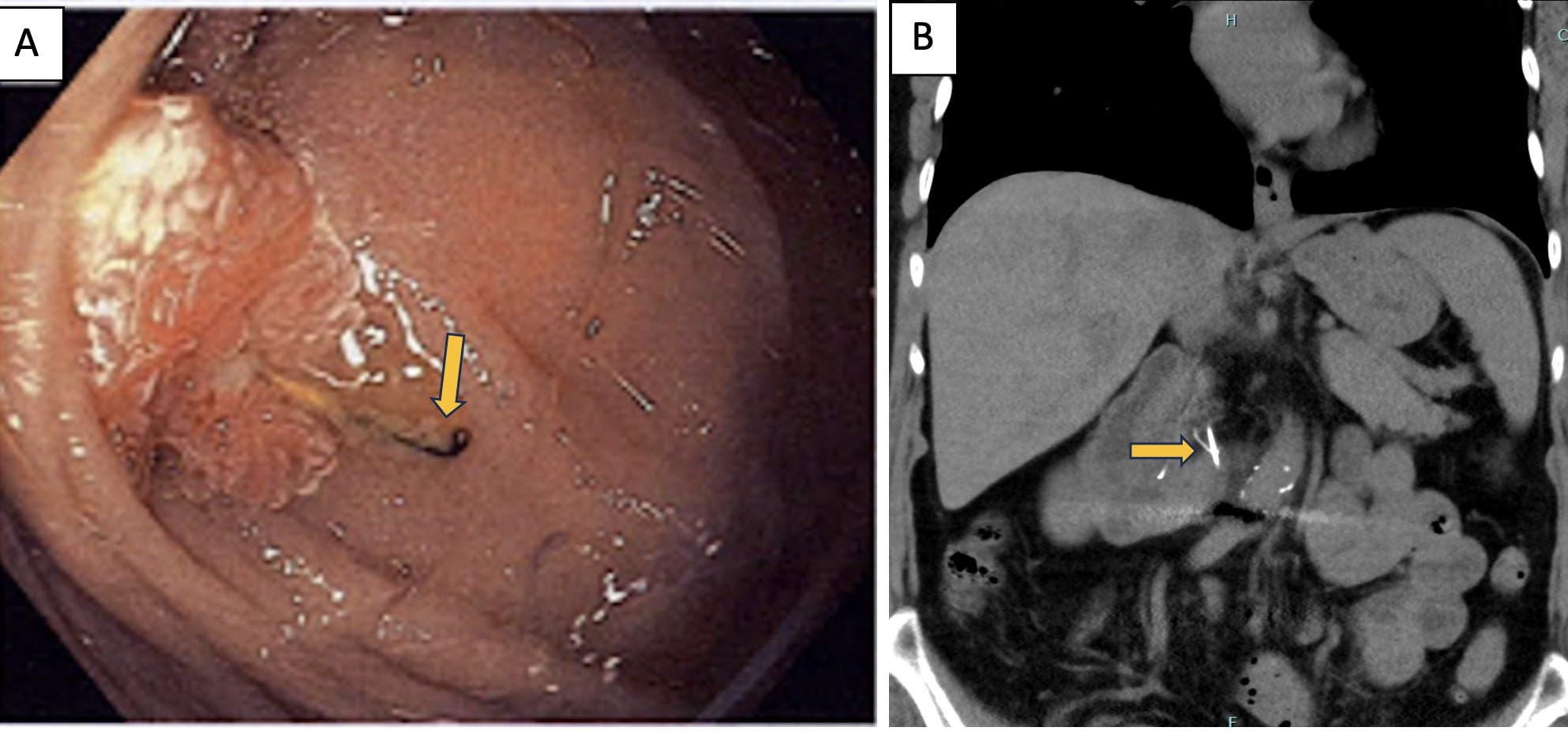Monday Poster Session
Category: General Endoscopy
P2431 - A Case of Successful Conservative Management in a Patient With Duodenum Penetration Caused by a Migrated IVC Filter
Monday, October 28, 2024
10:30 AM - 4:00 PM ET
Location: Exhibit Hall E

Has Audio
- PP
Paola Peña, MD
Roger Williams Medical Center
Providence, RI
Presenting Author(s)
Aryanna Sousa, MD, MPH, Paola Pena, MD, Qusai Al Masad, MD, Nabil Toubia, MD
Roger Williams Medical Center, Providence, RI
Introduction: Inferior vena cava (IVC) filters effectively prevent pulmonary embolism (PE), and their implantation offers low morbidity and mortality. Migration into the duodenum is a rare late complication and can present with abdominal pain or GI bleeding. This is a case of an asymptomatic IVC filter penetrating the duodenum managed conservatively.
Case Description/Methods: The case was extracted from a chart review. A 73-year-old Latino female with a history of hyperlipidemia, cholelithiasis status post cholecystectomy, IBS, and GERD suffered multiple traumatic injuries after an MVA in 2004. An IVC filter was placed during the admission, and she was not started on anticoagulation upon discharge. Between 2005 and 2010, due to persistent symptoms of GERD and unspecific abdominal pain, the patient underwent 3 EGDs, 2 colonoscopies, and 1 rectal sigmoidoscopy without significant findings other than mild gastric antral erythema and internal hemorrhoids. In 2018, a screening colonoscopy was done now in the US. The patient was asymptomatic for several years and denied episodes of bleeding. The colonoscopy showed a polyp in the second portion of the duodenum, with an externalizing metal clip noted. The pathology revealed a fundic gland polyp. EUS showed a metal object extending beyond the duodenal wall into the vascular structures in the retroperitoneum, likely the IVC. CT, without contrast, confirmed the position. The general and vascular surgery specialists consulted opted not to remove the IVC filter, as a well-scarred fistula had formed in the duodenum. A venogram ruled out IVC filter thrombus. In 2023, follow-up abdominal pelvis CT showed stable findings of IVC filter. The patient remains asymptomatic, with stable labs and no signs of GI bleed.
Discussion: Only two other cases in the literature described patients with duodenal perforation as a complication of IVC filter treated conservatively. Our patient had a stable scar on the posterior wall of the duodenum against the vena cava, where the foreign body was located. The surgical removal of the IVC filter could open up the scar, and there was no guarantee that the duodenum repair could be made without a leak. Only if the patient developed RUQ pain would a repeat EGD with biopsy be indicated to rule out an abscess. IVC filters should be removed as soon as they are no longer necessary. As the guidelines regarding such patients are unclear, a conservative approach can be made after multidisciplinary evaluation and a shared decision with the patient.

Disclosures:
Aryanna Sousa, MD, MPH, Paola Pena, MD, Qusai Al Masad, MD, Nabil Toubia, MD. P2431 - A Case of Successful Conservative Management in a Patient With Duodenum Penetration Caused by a Migrated IVC Filter, ACG 2024 Annual Scientific Meeting Abstracts. Philadelphia, PA: American College of Gastroenterology.
Roger Williams Medical Center, Providence, RI
Introduction: Inferior vena cava (IVC) filters effectively prevent pulmonary embolism (PE), and their implantation offers low morbidity and mortality. Migration into the duodenum is a rare late complication and can present with abdominal pain or GI bleeding. This is a case of an asymptomatic IVC filter penetrating the duodenum managed conservatively.
Case Description/Methods: The case was extracted from a chart review. A 73-year-old Latino female with a history of hyperlipidemia, cholelithiasis status post cholecystectomy, IBS, and GERD suffered multiple traumatic injuries after an MVA in 2004. An IVC filter was placed during the admission, and she was not started on anticoagulation upon discharge. Between 2005 and 2010, due to persistent symptoms of GERD and unspecific abdominal pain, the patient underwent 3 EGDs, 2 colonoscopies, and 1 rectal sigmoidoscopy without significant findings other than mild gastric antral erythema and internal hemorrhoids. In 2018, a screening colonoscopy was done now in the US. The patient was asymptomatic for several years and denied episodes of bleeding. The colonoscopy showed a polyp in the second portion of the duodenum, with an externalizing metal clip noted. The pathology revealed a fundic gland polyp. EUS showed a metal object extending beyond the duodenal wall into the vascular structures in the retroperitoneum, likely the IVC. CT, without contrast, confirmed the position. The general and vascular surgery specialists consulted opted not to remove the IVC filter, as a well-scarred fistula had formed in the duodenum. A venogram ruled out IVC filter thrombus. In 2023, follow-up abdominal pelvis CT showed stable findings of IVC filter. The patient remains asymptomatic, with stable labs and no signs of GI bleed.
Discussion: Only two other cases in the literature described patients with duodenal perforation as a complication of IVC filter treated conservatively. Our patient had a stable scar on the posterior wall of the duodenum against the vena cava, where the foreign body was located. The surgical removal of the IVC filter could open up the scar, and there was no guarantee that the duodenum repair could be made without a leak. Only if the patient developed RUQ pain would a repeat EGD with biopsy be indicated to rule out an abscess. IVC filters should be removed as soon as they are no longer necessary. As the guidelines regarding such patients are unclear, a conservative approach can be made after multidisciplinary evaluation and a shared decision with the patient.

Figure: Fig. 1 A: EGD showing metal clip (arrow) externalizing from a polyp in the second portion of the duodenum. B: Coronal view of abdominal CT without contrast showing the anterior legs of the IVC filter (arrow) extending into the duodenum.
Disclosures:
Aryanna Sousa indicated no relevant financial relationships.
Paola Pena indicated no relevant financial relationships.
Qusai Al Masad indicated no relevant financial relationships.
Nabil Toubia indicated no relevant financial relationships.
Aryanna Sousa, MD, MPH, Paola Pena, MD, Qusai Al Masad, MD, Nabil Toubia, MD. P2431 - A Case of Successful Conservative Management in a Patient With Duodenum Penetration Caused by a Migrated IVC Filter, ACG 2024 Annual Scientific Meeting Abstracts. Philadelphia, PA: American College of Gastroenterology.
